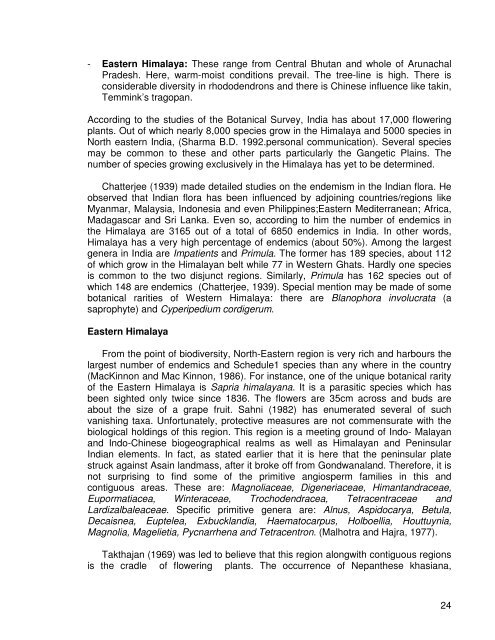Pandit Govind Ballabh Pant Memorial Lecture: II
Pandit Govind Ballabh Pant Memorial Lecture: II
Pandit Govind Ballabh Pant Memorial Lecture: II
Create successful ePaper yourself
Turn your PDF publications into a flip-book with our unique Google optimized e-Paper software.
- Eastern Himalaya: These range from Central Bhutan and whole of Arunachal<br />
Pradesh. Here, warm-moist conditions prevail. The tree-line is high. There is<br />
considerable diversity in rhododendrons and there is Chinese influence like takin,<br />
Temmink’s tragopan.<br />
According to the studies of the Botanical Survey, India has about 17,000 flowering<br />
plants. Out of which nearly 8,000 species grow in the Himalaya and 5000 species in<br />
North eastern India, (Sharma B.D. 1992.personal communication). Several species<br />
may be common to these and other parts particularly the Gangetic Plains. The<br />
number of species growing exclusively in the Himalaya has yet to be determined.<br />
Chatterjee (1939) made detailed studies on the endemism in the Indian flora. He<br />
observed that Indian flora has been influenced by adjoining countries/regions like<br />
Myanmar, Malaysia, Indonesia and even Philippines;Eastern Mediterranean; Africa,<br />
Madagascar and Sri Lanka. Even so, according to him the number of endemics in<br />
the Himalaya are 3165 out of a total of 6850 endemics in India. In other words,<br />
Himalaya has a very high percentage of endemics (about 50%). Among the largest<br />
genera in India are Impatients and Primula. The former has 189 species, about 112<br />
of which grow in the Himalayan belt while 77 in Western Ghats. Hardly one species<br />
is common to the two disjunct regions. Similarly, Primula has 162 species out of<br />
which 148 are endemics (Chatterjee, 1939). Special mention may be made of some<br />
botanical rarities of Western Himalaya: there are Blanophora involucrata (a<br />
saprophyte) and Cyperipedium cordigerum.<br />
Eastern Himalaya<br />
From the point of biodiversity, North-Eastern region is very rich and harbours the<br />
largest number of endemics and Schedule1 species than any where in the country<br />
(MacKinnon and Mac Kinnon, 1986). For instance, one of the unique botanical rarity<br />
of the Eastern Himalaya is Sapria himalayana. It is a parasitic species which has<br />
been sighted only twice since 1836. The flowers are 35cm across and buds are<br />
about the size of a grape fruit. Sahni (1982) has enumerated several of such<br />
vanishing taxa. Unfortunately, protective measures are not commensurate with the<br />
biological holdings of this region. This region is a meeting ground of Indo- Malayan<br />
and Indo-Chinese biogeographical realms as well as Himalayan and Peninsular<br />
Indian elements. In fact, as stated earlier that it is here that the peninsular plate<br />
struck against Asain landmass, after it broke off from Gondwanaland. Therefore, it is<br />
not surprising to find some of the primitive angiosperm families in this and<br />
contiguous areas. These are: Magnoliaceae, Digeneriaceae, Himantandraceae,<br />
Eupormatiacea, Winteraceae, Trochodendracea, Tetracentraceae and<br />
Lardizalbaleaceae. Specific primitive genera are: Alnus, Aspidocarya, Betula,<br />
Decaisnea, Euptelea, Exbucklandia, Haematocarpus, Holboellia, Houttuynia,<br />
Magnolia, Magelietia, Pycnarrhena and Tetracentron. (Malhotra and Hajra, 1977).<br />
Takthajan (1969) was led to believe that this region alongwith contiguous regions<br />
is the cradle of flowering plants. The occurrence of Nepanthese khasiana,<br />
24











